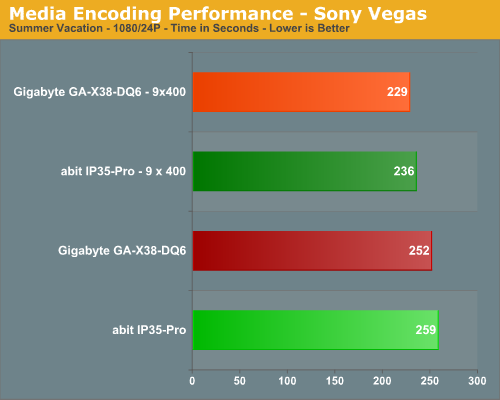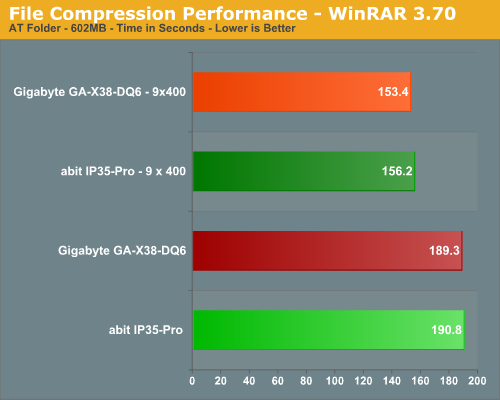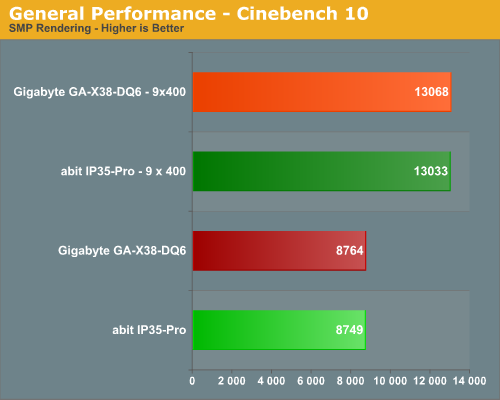Gigabyte GA-X38-DQ6: An early look at X38
by Gary Key on September 4, 2007 3:00 AM EST- Posted in
- Motherboards
Media Encoding Performance
We are utilizing Nero Recode 2 and Sony Vegas 7.0e for our video encoding tests. The scores reported include the full encoding process and are represented in seconds, with lower numbers indicating better performance.
Our first series of tests is quite easy - we take our original Office Space DVD and use AnyDVD to rip the full DVD to the hard drive without compression, thus providing an almost exact duplicate of the DVD. We then fire up Nero Recode 2, select our Office Space copy on the hard drive, and perform a shrink operation to allow the entire movie along with extras to fit on a single 4.5GB DVD disc. We leave all options on their defaults except we uncheck the advanced analysis option.

We find in this CPU and disk intensive test that both boards score equally, which is not surprising since both boards utilize the same ICH9R Southbridge and considering the early nature of Gigabyte board.
Our Sony Vegas 7.0e test converts several of our summer vacation files into one plasma screen pleasing 1080/24P format with a 5.1 audio stream. We ensure our quality settings are set to their highest levels and then let the horses loose.

In a test that really stresses the CPU and memory subsystem, we see the Gigabyte board is about 3% faster at stock and overclocked speeds than the abit board.
File Compression Performance
In order to save space on our hard drives and provide another CPU crunching utility, we utilize WinRAR 3.70 to perform some compression tests. WinRAR now fully supports multithreaded operations and should be of particular interest for those users with dual core or multi-processor systems. Our test folder contains 444 files, ten subfolders, and 602MB worth of data. All default settings are utilized in WinRAR and our hard drive is defragmented before each test.

Once again we see the early X38 engineering sample from Gigabyte performing well in a test that stresses overall memory latencies and CPU/Memory throughput. However, this is one of our application benchmarks where we thought the X38 would perform measurably better against the P35. The nature of file compression is such that memory is accessed almost constantly in a very random fashion, so page misses requiring additional time as memory banks are swapped is common. The Gigabyte board is 2% quicker at stock and about 1% faster when overclocked than the abit board. This indicates slightly better memory/CPU throughput capabilities, but it's not at the level we expected - at least not yet.
Rendering Performance
We are using the Cinebench 10 benchmark as it tends to heavily stress the CPU subsystem while performing graphics modeling and rendering. Cinebench 10 features two different benchmarks with one test utilizing a single core and the second test showcasing the power of multiple cores in rendering the benchmark image. We utilize the standard multi-core benchmark and default settings.

Once again we see the X38 equipped board finishing ahead of the P35 board, although the differences are less than a percent.
We are utilizing Nero Recode 2 and Sony Vegas 7.0e for our video encoding tests. The scores reported include the full encoding process and are represented in seconds, with lower numbers indicating better performance.
Our first series of tests is quite easy - we take our original Office Space DVD and use AnyDVD to rip the full DVD to the hard drive without compression, thus providing an almost exact duplicate of the DVD. We then fire up Nero Recode 2, select our Office Space copy on the hard drive, and perform a shrink operation to allow the entire movie along with extras to fit on a single 4.5GB DVD disc. We leave all options on their defaults except we uncheck the advanced analysis option.

We find in this CPU and disk intensive test that both boards score equally, which is not surprising since both boards utilize the same ICH9R Southbridge and considering the early nature of Gigabyte board.
Our Sony Vegas 7.0e test converts several of our summer vacation files into one plasma screen pleasing 1080/24P format with a 5.1 audio stream. We ensure our quality settings are set to their highest levels and then let the horses loose.

In a test that really stresses the CPU and memory subsystem, we see the Gigabyte board is about 3% faster at stock and overclocked speeds than the abit board.
File Compression Performance
In order to save space on our hard drives and provide another CPU crunching utility, we utilize WinRAR 3.70 to perform some compression tests. WinRAR now fully supports multithreaded operations and should be of particular interest for those users with dual core or multi-processor systems. Our test folder contains 444 files, ten subfolders, and 602MB worth of data. All default settings are utilized in WinRAR and our hard drive is defragmented before each test.

Once again we see the early X38 engineering sample from Gigabyte performing well in a test that stresses overall memory latencies and CPU/Memory throughput. However, this is one of our application benchmarks where we thought the X38 would perform measurably better against the P35. The nature of file compression is such that memory is accessed almost constantly in a very random fashion, so page misses requiring additional time as memory banks are swapped is common. The Gigabyte board is 2% quicker at stock and about 1% faster when overclocked than the abit board. This indicates slightly better memory/CPU throughput capabilities, but it's not at the level we expected - at least not yet.
Rendering Performance
We are using the Cinebench 10 benchmark as it tends to heavily stress the CPU subsystem while performing graphics modeling and rendering. Cinebench 10 features two different benchmarks with one test utilizing a single core and the second test showcasing the power of multiple cores in rendering the benchmark image. We utilize the standard multi-core benchmark and default settings.

Once again we see the X38 equipped board finishing ahead of the P35 board, although the differences are less than a percent.










26 Comments
View All Comments
jay401 - Tuesday, September 4, 2007 - link
How does it compare to the previous gen motherboards almost everyone is running?Is it really worth an upgrade from 650i/680i/P965/975X?
That's really what matters.
TA152H - Tuesday, September 4, 2007 - link
The chart "Media encoding - Sony Vegas" makes no sense. I think you got the stock performances twisted.Also three to five percent over the P35 sounds incredible, as in not credible. Especially with the Penryn (with it's bigger cache). When the motherboard makers talk this, you should try to find out what processor they are talking about. Maybe on a 512K processor it can reach it, but on a 4 MB processor, on most benchmarks, it doesn't sound realistic at all. Well, it also depends what they are comparing it to. It says the P35, but maybe they meant the 975X, which is much more likely. Crossfire, of course, will be much higher, but how many people are actually using this? It's a very, very low percentage. So, I think people are going to be disappointed again, like they were with the Penryn, because of misguided expectations. Penryn, like x38, is a great product, it's a shame people lose that because of these unrealistic expectations. Still, anything is possible, but if it averages 4% on most applications against the P35, on a Penryn (will enthusiasists buy the Conroe when it comes out?), I'd be very surprised.
One suggestion, when you do the final review, run it with a Conroe-L as well. Why would an enthusiast site run this as well? Well, if I needed a machine, right now (as in I had one computer and it died), I would buy it for $40 and then buy a Penryn when it became available, or cheap, and then use it in a low power computer. You might see the 3-5% claim have a chance on a small cache processor. That's probably what they were talking about, without actually wanting to say it.
phusg - Tuesday, September 4, 2007 - link
Sounds an interesting upgrade path. But aren't Conroe-L's the Celeron 4xx's which are socket 478? Do we even know what socket Penryn will be?
TA152H - Tuesday, September 4, 2007 - link
Conroe-L is LGA 775, same as Penryn will be. I suspect almost any motherboard being made now will work with the Penryn, or whatever the desktop version is called, really. I can't keep up with these stupid names AMD and Intel come up with for their processors. The ass that thought of Barcelona should be sterilized. What an absurd name. If they had any brains they might make code names and add something like -L for light, -M for mobile, -S for server, -QM for Quad Mobile, etc...Instead, they have these horrendous code names, which are suitably replaced by horrendous model numbers. I really can't keep track. Pentium III 1 GHz was so much easier to remember.
Guuts - Tuesday, September 4, 2007 - link
Gary,Page 2: Third paragraph from the bottom, should have (DDR2-1066) and not (DDR-1066).
Page 3: Missing graphic at the top of the page, text starting off with "memory-lg.png memory-sm.png" is probably the cause?
Page 5: Chart 2 (Sony Vegas) either has the stock speed bars' labels reversed, or your text summary is incorrect, as the chart doesn't show the Gigabyte board ahead in both stock and overclocked speeds.
Page 7: Second paragraph, last sentence, "...better than several retails boards" should just be "retail".
Good article overall, though I was expecting a bit more of an improvement over the P35. I bet there will be a nice boost over the 975X when we see the full review, however. Thanks for the early look, Gary.
Now...where is the P35 board roundup? :-p
JarredWalton - Tuesday, September 4, 2007 - link
Hi - sorry about the graph missing... that was my mistake. You can blame me for a few other missed typos as well if you'd like. I'm not sure on the Sony Vegas chart if there's some sort of labeling error or if we need to correct the text, so I'm leaving it alone.--Jarred